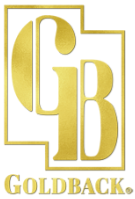Top Qs
Timeline
Chat
Perspective
Goldback
Fractional gold bullion in a banknote style marketed as a 'Goldback' From Wikipedia, the free encyclopedia
Remove ads
The Goldback is a fractional gold commercial product marketed as a local currency and commodity which has seen limited use in some U.S. states, and is sold and marketed by Goldback, Inc. of Utah. The Goldback contains a thin layer of gold within a polymer coating equivalent to 1/1000 of an ounce.[1]
Remove ads
Overview
Goldbacks are shaped like banknotes but contain a small amount of 24 karat gold. The gold is contained between two layers of clear, decorated polyester. Goldbacks are sold in increments labelled 1/2, 1, 2, 5, 10, 25, 50, and 100 each containing proportionally larger amounts of gold.[2][3][4] Goldbacks are minted by Valaurum, a private mint.
Valaurum uses a vacuum deposition process to fuse gold together into thin sheets encased in a plastic film designed to hold the gold.[2][5]
The Utah Goldback was released in 2019, with series for Nevada, New Hampshire, Wyoming, and South Dakota launched in 2020, 2021, 2022, and 2023 respectively.[6] The Florida series was released on January 15[7] of 2025.[8]
- Front side of a single (one) New Hampshire edition Goldback
- Back side of a single (one) New Hampshire edition Goldback
Remove ads
Reported use

KSL 5 TV, the NBC affiliate of Salt Lake City, reported a small number of local businesses accepting using Goldbacks for everyday transactions.[4]
In association with members of the libertarian Free State Project in New Hampshire, widespread use has been reported of people spending Goldbacks on various goods and services within the state.[9][verification needed]
Remove ads
Design
Each Goldback features a figure representing a cardinal virtue[citation needed], as well as animals and plants native to the state they are being marketed in. While each series is different in design, they all contain the same amount of gold.[10][better source needed]

Local legislation
The Goldback has not been adopted by any state government; it is privately issued and developed to be used at the local state level.
In Utah, the Utah State Legislature expanded the definition of gold for legal tender—explicitly making gold with a "polymer holder" or "coating" not subject to the state sales tax—specifically any metal that, "...has a gold, silver, or platinum metallic content of 50% or more, exclusive of any transparent polymer holder, coating, or encasement..."[11] The first Goldbacks were made for Utah, partly as a result of the legalization of gold and silver as legal tender in Utah in 2011 as part of the Utah Legal Tender Act, and partly because the founder and first employees were based out of Utah.[12]
In order to avoid issues with federal counterfeit laws, each Goldback is printed with statements such as, "voluntary negotiable instrument" "for circulation" specific to whichever state the particular Goldback in question was 'printed' for. Also, the text "Privately Issued, Not U.S. Dollar Legal Tender. US & International Patents Pending" appears on each Goldback.[6]
Remove ads
Criticism
Some commentators have stated that one potential downside of the Goldback is the premium that each Goldback costs over the spot price of gold embedded within each note.[13] Currently, as of April 2025, the premium-to-gold price is around 100%.
See also
References
Wikiwand - on
Seamless Wikipedia browsing. On steroids.
Remove ads



